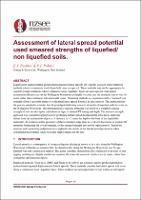Assessment of lateral spread potential used smeared strengths of liquefied/non liquefied soils
Abstract
Liquefaction-induced lateral ground displacements (lateral spread) are typically assessed using empirical methods where a continuous weak (liquefied) layer is expected. These methods are not appropriate for variable fill materials where continuous weak (liquefied) layers are not expected. End-tipped reclamation fill materials on the Wellington Waterfront are highly variable, and the materials tend to vary by zones rather than continuous sub-horizontal layers. Numerical methods in conjunction with a ‘smeared’ soil strength offered a possible means of evaluating lateral spread potential in this situation. This paper presents the process adopted to estimate lateral spread potential using smeared strengths of liquefied soils for a site on the Wellington Waterfront. The determination of smeared strengths was based on a weighted average strength of soils divided up by soil behaviour type (Ic) from CPT testing and depth. The smeared strength approach was considered appropriate for predicting lateral spread displacements at locations relatively distant from the reclamation edge (i.e. A distance of > 2 times the depth to the base of the liquefiable materials). At locations within proximity of the reclamation edge there is a risk of a local zone of weaker fill materials dominating the overall strength, so the smeared strength may not be representative. Sensitivity analyses and engineering judgement were applied to the results of the lateral spread predictions when considering the potential range of ground displacements for the site.

